On my latest backpacking trip, I had plenty of opportunity to put the Giottos RT-8150 through the paces. For the most part, I found it a real pleasure to use. It was easy to deploy and strong enough to support my 25 oz (709 g) DSLR. One thing I noticed, though, is that the head sometimes required a bit of fiddling in order to get the composition I wanted in the viewfinder. Being more accustomed to traditional ball heads, I soon found that this slowed me down in the field and got in the way of the creative process. In short, it was annoying. Upon arriving back home, I decided to take care of this problem. There was only one solution: Off with her head.
~~~~~~~~~~~~~~~~~~~~~~~~~~
Tools Needed: Hacksaw. 1/4″ round file.
Parts needed: Giottos MH 1004 Min Ball Head.
Hardware needed: 1/4″-20×1″ bolt, 14s flat washer, 1/4″ lock washer.
Step 1: Saw the head off your Giottos RT-8150. Cut as close to the metal triangular cap that covers the hinge assembly as you can get. Don’t worry about scuffing it. You’ll probably decide not to use it, but if you do, you can always touch it up with black paint.
Step 2: Pull off the metal cap and set it aside.
Step 3: This is an optional step, but it will save you 0.3 oz (8 g). Unscrew each leg from the hinge assembly and pull off the silver caps.

 Step 4: With the round file, take off the little bits of metal in the hole of the hinge assembly that are blocking you from inserting the 1/4″ screw. Alternately, you can use an electric drill and 1/4″ bit.
Step 4: With the round file, take off the little bits of metal in the hole of the hinge assembly that are blocking you from inserting the 1/4″ screw. Alternately, you can use an electric drill and 1/4″ bit.
Step 5: Insert the 1/4″ screw and 14s flat washer into the bottom of the hinge assembly. Larger diameter washers will prevent the legs of the tripod from closing completely.
Step 6: Put the 1/4″ lock washer onto the bolt. Screw the Giottos MH 1040 ball head onto the bolt until is finger tight. Make sure the thumbscrew on the ballhead is locked down before you do this.
Step 7: Screw the legs back onto the hinge assembly.
Step 8: Let’s weigh it. 12.3 oz. (349 g) total. Not bad. We saved 6 oz. (170 g) or almost a third of the original weight. Just as important, we gained function.
Let’s take it outside.
Like the original head, the Giottos MH 1004 will hold my camera still without slipping, even in portrait orientation. Unlike with the original head, I can quickly and easily point the camera in any direction I want.
Taking off the metal hinge assembly cap allows each leg to be opened at any angle you choose. This is really an advantage when setting up your tripod on uneven ground. Combined with the eight section legs this gives you infinite height adjustment, from the ground up to it’s full height. What you’re giving up is the ability to lock the leg angle. From experimentation with the modified tripod, I’ve found that in outdoors situations, you really don’t need to lock the legs. The ground provides enough friction to hold the leg angles steady as long as you use a little common sense when setting up the tripod But if you’re worried about the tripod legs slipping out and destroying your expensive camera, you can just put the metal cap back on. This will add an additional 0.6 oz. (17 g).
“““““““““““““““““““““““““`
Comparison with Zipshot:
The closest competitor in this weight class to my modified Giottos RT-8150 is the Tamrac Zipshot. Let’s compare them head to head.
Weight: The modified Giottos weighs 12.3 oz.(349 g) while the Zipshot weighs 11.1 oz.(315 g). Slight advantage to the Zipshot.
Height: From the floor to the top of the modified Giottos is 40.25″ (102cm). For the Zipshot, it’s 41.25 ” (105 cm). Again a slight advantage to the Zipshot.
Compactness: When collapsed, the modified Giottos is 11.75″ (30cm) long with a circumference of 4.25″ (11cm). The Zipshot is 15.75″ (40cm) long with a 5″ (13 cm) circumference. Advantage goes to the Giottos.
Speed of Deployment: Both are much quicker than a traditional tripod. With the Zipshot, you undo two pieces of shock cord and shake the tripod until the legs snap into position. In practice, sometimes you have to assemble some of the leg sections by hand, but it’s still a very quick process. With the Giottos, you pull each of the telescoping legs out, then twist the second from the top leg sections to lock them. Both processes are very quick and easy and neither tripod has an advantage here.
Leg stability: Both are somewhat noodly and no match for the stability of heavier tripods. Both are fine in still conditions or in a light breeze as long as you turn on your image stabilization. Hanging your backpack from either one will help when the wind is stronger. I’ll call this one a draw.
Leg adjustability: The modified Giottos has infinite height adjustability due to the fact the it has eight sections and each leg can be set at a slightly different angle. The Zipshot basically has one setting that is easy to use and three others that can be set by folding up the legs and holding them in place with rubber bands. Advantage to the modified Giottos.
Ballhead: This is what I see as the big disadvantage to the Zipshot. The way the head attaches to the legs makes it wobble as you’re trying to set up your shot. In contrast, the head of the modified Giottos stays put where you set it.
Quality: This is admittedly a subjective evaluation, but I feel that the Giottos is superior to the Zipshot in quality. I didn’t think about this much before I started pulling the Giottos apart. My impression upon inspecting the individual parts of the Giottos is that it is well made and nicely put together.
Price: The Zipshot sells for $50. The Giottos RT-8150 costs $34 and the Giottos 1004 Mini Ball Head, $12.99. Add a few dollars for the hardware and you have a wash.
I’ll be testing the modified Giottos on my upcoming backpacking trips and reporting on what works, what doesn’t, and how things can be made better.




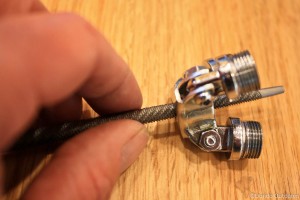

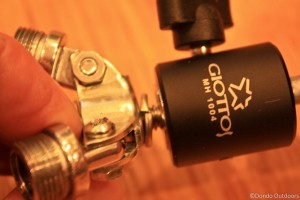
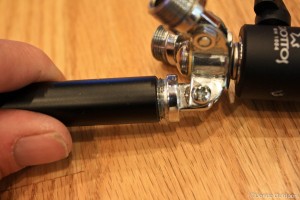


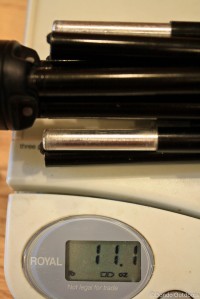



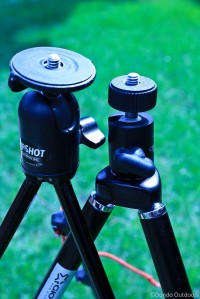

Thanks for posting this. I always struggle whether or not to take my DSLR for two reasons: (1) weight, and (2) with a camera, I often focus on photography rather than hiking. It’s on ongoing challenge how to balance the two competing drives, but with the first issue resolved, I may get more opportunities to work through it.
I will likely try to explore this project soon. Very awesome.
Thanks, Clayton. Glad I was able to help with the first issue. Not sure I can be of any help with the second. I’m still trying to find that balance myself. 🙂 I took a look at your blog, It’s very unique and inspirational. I’ll be spending some time there.
Thank you. I have already spent some time on your blog for a while, and I find much that brings me back.
Very cool indeed, Dondo – Thank You! A very nice hack; I just doubt that I’d be able to find any of the two (preferrably the Giottos) here. Ah well, off searching the interwebs 🙂
Glad you like it, Hendrik. Here’s a list of Giottos distributors including one in Helsinki. Maybe he can find you a tripod and head.
I like this, finding the parts may provide a challenge, but where there is a will there is a way. I came across this adaption to the Pacer Poles, which was also interesting http://pacerpole.com/administrator/Pacerpole_facebook_uploads/John_Dunn_Pacerpole_Tripod.pdf So plenty to experiment with. Thanks Dondo
Hi Roger. It’s seems that you and I are working through some of the same gear issues. Thanks for the link. It looks like a very clever solution. Let me know if you try it out.
TBH, I would prefer a separate tripod, for that reason I would prefer your option, I will possibly need to find an equivalent to the Giottos RT-8150 as they are not readily available in the Eu under that name. I will keep you posted.
Same here, Roger. After experimenting with my trekking pole tripod, I’ve come back around to preferring a separate tripod. The times when I most wanted to use the slower shutter speeds that required a tripod were in the early mornings and late evenings, times when the Shangri-La 2 was set up using my Pacerpoles. There were a few occasions before dawn when I had to collapse the wet inner walls of the shelter onto my gear because I needed to use the poles for a tripod. Also, you can’t use your poles for a tripod when your shelter is part of the composition.
Though I believe in multi-use, in this case I think I was taking the concept too far. 😉
Just ordered Giotto tripod and ball head. My camera is Nikon D5000, do you think this tripod will handle the weight with 70-200mm lens on it. Also can I find this additional hardware at home depot?
Hi mamamia,
You can find all the hardware at Home Depot. Look in the aisle where they have the hardware packaged into little bags. My Canon XS with 18-55 kit lens and polarizing filter weighs 25.2 oz., and the tripod has no problem handing it. I’m thinking that it may also be able to handle the weight of your longer lens. But test it in a safe situation first. Also, be sure to twist lock the second from the top sections of each leg before you commit any weight to it. Let me know how it works for you.
thank you, I saw your thread on BPlight and I am glad I found your post on getting a lightweight inexpensive Tripod. I also hae asked few questions on this thread, appreciate if you could provide some thoughts.http://www.backpackinglight.com/cgi-bin/backpackinglight/forums/thread_display.html?forum_thread_id=64756&skip_to_post=553682#553682
Just read the thread and pretty much agree with everything Bob and Franco said. If you can only bring one filter, make it a circular polarizer. A 4×6 graduated neutral density is very useful as well. I used to use a Cokin filter holder, but now just hand hold my ND filters in front of the lens and it seems to work fine. Since your tripod is only 40″ high, a piece of closed cell foam to kneel on while composing is also nice to have.
I was reading your thread over at Backpackinglight about the tent pole tripod you made. I’m reading here that you have abandoned that idea (maybe entirely) in favor of this new modified tripod and have now chosen to carry a dedicated tripod with you.
However, this tripod is far heavier than the tent pole tripod.
1) So, why did you not choose to not just carry an extra set of tent poles dedicated to tripod use and cut the carrying weight by 2/3rds?
2) Did over time, you find that the tent pole version did not function well enough in general or in some particular way or another so you went another route for that reason?
3) I was curious why you needed to use binder clips in your first tent pole version? Is it to sort of to hold the ferrules joint together? I didn’t understand the purpose of the clips at all. I thought the ferrules would be secure enough and that they should separate easily enough when finished. Are the clips just “added” security and so the shock cord later replaces that security? I’m a little green here, sorry…
4) Was the tent pole version capable of handling securely the weight of a 3lb DSLR with lens? I didn’t see anyone mention this and assume everyone uses small cameras for trekking. My use is not for trekking–just to have a tripod available for occasional end of day uses–that is as light as possible.
Thank you.
Hi Jerry,
All great questions. Let me attempt to answer them.
1) and 2) Over time, I found that my orignal design was not the tool I needed to meet my photographic objectives. For one, I wanted a ball head that would allow me to quickly and easily put my camera in the desired position and hold it firmly in place. Also, I wanted more height adjustment that my original design provided. For me, the greatly increased function of the hack described above is well worth carrying the extra eight ounces or so.
3) The binder clips just held the Fibraplex poles together. The later design using shock cord made for a tripod that could be more quickly and easily deployed.
4) I’m not sure about three pounds, but the tent pole version had no problem holding my 1.5 pound DSLR+lens combo.
Thanks for your reply and I realize that as tempting as a 4 oz tripod would be, I’d eventually be frustrated with that arrangement for a number of the reasons you mentioned.
The Giotto tripod mods appeal to me but I’m at the limit of the rated capacity of the tripod. I have the Canon T2i with it’s 18-135 lens which weighs in at 2.24 lbs.
In the B&H comments section for this tripod, someone with a similar weighing Nikon set up said the legs were “flimsy” and tended to collapse under the weight when he used his 18-135 lens.
Is it possible to tighten the legs more to make it lock stronger in your opinion?
I assume the commenter must have tried this though.
BUT, I’m thinking that I would still be OK, or very close to it, regardless. Cutting off the head and saving 6 ounces would reduce my stress weight on the legs from 2.24 lbs to 1.87 lbs, less than a tenth of a lb over–close to the stated maximum–hopefully close enough.
The commenter was using the original heavier ball assembly that came with the tripod–not your substitution.
Any thoughts?
Any issues for you with legs slipping out of locked positions?
Jerry, I read the comment you referred to at B&H and am mystified at how the commenter managed to collapse the tripod with the weight he put on it. When I was testing it, I put 20 lb. on it with no collapse. My best guess is that he didn’t figure out how to lock the two top sections of the legs together with a simple twist.
That said, it is true that this tripod is not the most stable. To get something with rock-solid stability, you would have to be willing to carry a lot more weight and spend a lot more money.
But I don’t think you have to worry about the legs slipping out. It just hasn’t been an issue.
Thanks very much for posting this. I’ve built one too and it looks pretty good. I’ve added a Slik DQ-10 quick-release to speed up setup and pulldown, because I’m generally hiking with people who only have limited patience for my taking photos.
Regarding stability, I do think it helps a little to leave the little black cap on the top. Because then the legs spead out and press against the cap, reducing their ability to move. That’s my impression anyway.
Hi Frank, I’m glad you found my post useful. I do agree with you that the black cap helps with stability. The down side comes when you’re dealing with uneven terrain. Taking the cap off allows you to extend one or more legs at a more extreme angle. Balancing the tradeoffs is one of the things I find endlessly fascinating about our hobby.
I can relate to your comment about hiking companions having limited patience with photography. Often I find myself racing ahead of the group or dropping behind in order get the shot
.
Question. I just received my order from amazon on this tripod with plans to do this mod. I ordered the Giottos RT-8150, but the sticker on the tripod says Giottos RT-8000. anyone know if they are the same? they look similar, but when I look at part you need to cut off, I don’t see how that will release the ball head from the legs. There looks to be a flange part of the ball head shaft that keeps the black cap on. I fear that if I cut the shaft part of the ball head off the flange will still keep the cap and shaft attached to the legs. see photos here : http://i.imgur.com/7QC3iJz.jpg
Hi Pat, It’s been a while since I did this project, so I can’t remember the particulars. But since I have a scuffed black cap on hand, I’m guessing that I forced the hacksaw blade under the flange to cut off the head. Good luck and let us know if that works for you.